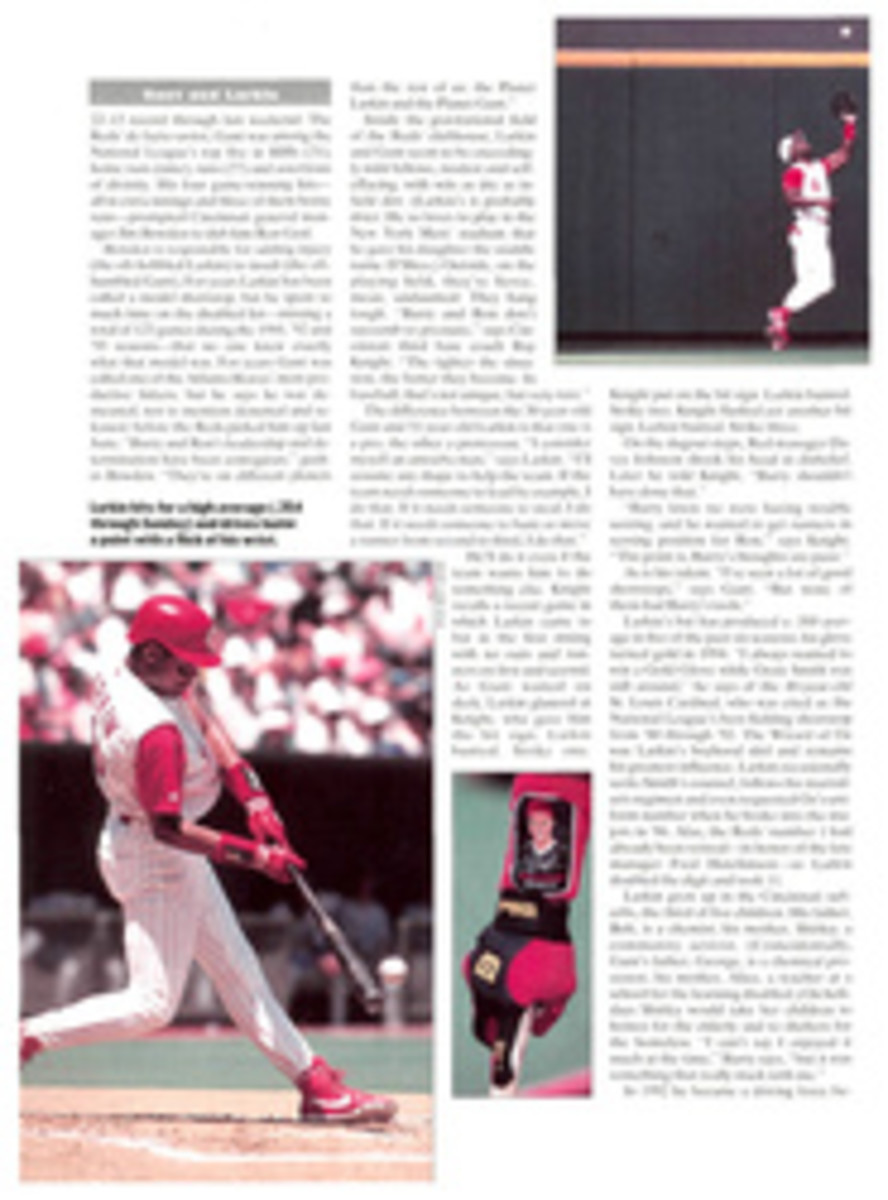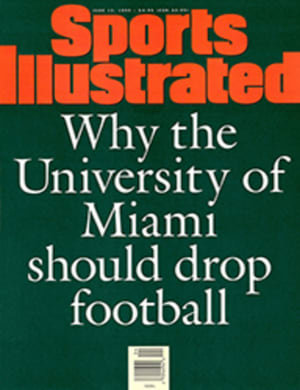
EVERYONE INTO THE POOL STADIUM SAILING IS LIKE A MINIATURE AMERICA'S CUP BUT A LOT MORE FUN
Not so much as a ripple stirred the glassy water in Ann Arbor on
April 8 as 16 skippers huddled for a prerace briefing with Brad
Dellenbaugh, the offshore sailing coach at the U.S. Naval
Academy and the umpire of the day's regatta. Just as Dellenbaugh
had promised, a steady eight-knot breeze gusted up right after
he bade the sailors good luck. Conditions were clear and fine,
except for a whiff of chlorine. The usual nautical scene ensued.
Sails luffed, bows sliced the water and skippers squinted
windward. But the entire spectacle took place on the University
of Michigan's 50-meter pool.
Stadium sailing, the yachting equivalent of arena football,
brings the high-seas maneuvers of match racing indoors. As
America's Cup crews sparred off San Diego this spring, a
scaled-down version of their event took place in pools in 16
cities across the U.S. Ann Arbor was the 12th stop on the tour,
which culminated in San Diego, where the regional winners met in
the championship regatta on May 13. "You've never sailed in a
swimming pool before," Dellenbaugh told the skippers in Ann
Arbor, "and you probably never will again."
Chevrolet dreamed up stadium sailing last summer as a way to
publicize its sponsorship of America3, the syndicate that won
the 1992 America's Cup and sought unsuccessfully to defend it
this spring with a mostly female crew aboard a new yacht, Mighty
Mary. Indoor sailing might have been dismissed as far-fetched
were it not for Derrick Fries, a renowned Michigan racer and the
master small-boat instructor at the U.S. Sailing Association,
who endorsed the idea as a way to showcase grassroots
participants in a sport often stigmatized as a pastime of the
lockjawed blue-blazer set. "We're trying to redefine the culture
of sailing," the 41-year-old Fries says. "We'd like it to
undergo the same democratization tennis enjoyed in the 1970s.
Stadium sailing could be the shift we need. It could put sailing
in a new light."
The first challenge for Fries, Dellenbaugh and Buddy Melges, the
co-helmsman of the '92 America3 team, was to find a boat that
could be raced indoors without looking goofy. Dellenbaugh's
brother Dave, who was Mighty Mary's tactician and her only male
crew member, had sailed in a stadium race in France in 1992 in
which mini-twelves -- 12-foot replicas of the 12-meter yachts
sailed in the America's Cup from 1958 to 1987 -- were used. And
since the mid-'80s Melges had seen mini-twelves sailed near his
boatyard on Wisconsin's Lake Geneva. Last fall Melges procured a
few mini-twelves from local residents and businesses and shipped
them to the University of Illinois in Chicago. There he, Dave
Dellenbaugh and Fries -- three of America's top helmsmen -- were
propelled by 12 poolside electric fans in circles around a
50-meter swimming pool.
With undersized rudders and 225-pound ballasts in their keels,
the mini-twelves handled sluggishly. "The first time I got in
the boat," Fries says, "I rammed right into the side of the pool
because the steering is counterintuitive." Melges made the boats
more maneuverable by shrinking jibs so they wouldn't drag across
masts on tacks and by enlarging mainsails to provide more power.
He also increased the number of fans to 24. "By the time we put
the boat before the public in January," Melges says, "it was
butter-smooth."
Watching the America's Cup, Damon Runyon once said, is as
exciting as watching the grass grow. And indeed, to the
uninitiated, yachting's premier event can seem like nothing more
than a distant series of incomprehensible maneuvers. Did anyone
really expect the indoor version to enthrall? "No way," says
umpire Mary Savage. "Not until 500 people showed up at our
inaugural event in Chicago. They were booing and screaming,
'Tack!' 'Don't tack!' 'Watch out!' The audience was so into it."
You won't see Dennis Conner in stadium sailing, but you will see
local heroes performing for hometown crowds. For the Ann Arbor
regatta the best 16 racers, ages 14 to 59, were picked from a
pool of 150 applicants. They were a seasoned group, experienced
in racing everything from lowly Sunfish to offshore yachts. But
even Lake Huron's finest had never seen anything like this:
Slouched inside the 12-foot boats like Grand Prix drivers
scrunched into bumper cars, skippers steered with foot pedals
while adjusting their jibs and mainsail sheets with their hands.
Powered by winds from enormous electric fans at one end of the
pool, the boats raced head-to-head around an upwind-downwind
course modeled on those used in America's Cup competition.
Racers with the lowest combined times in two heats advanced to
the next round. Poolside umpires assessed penalties for illegal
maneuvers, which sailors absolved by sailing a penalty circle.
"It's totally, absolutely, entirely different from anything I've
ever done in a sailboat," said quarterfinalist Josh Kerst, a
29-year-old engineer from Ann Arbor. "The only thing that's the
same is my damp fanny."
In some ways stadium sailing is more demanding than the outdoor
version. As they tried to adjust to steering with foot pedals,
these experienced skippers swerved around the Michigan
natatorium's pool like disoriented student drivers. "It's second
nature for us to handle a tiller or a wheel," said Peter
Shumaker, a Grosse Point, Mich., dentist. "All of a sudden we
have to think with our feet and not with our hands." As if that
weren't confusing enough, the skippers also had to jockey for
position on the pool's restrictive playing field without
colliding or drifting into the doldrums at the becalmed leeward
end of the pool. "My feet were twitching in anticipation," said
Kerst. "I forgot to breathe."
The odd demands of stadium sailing don't always favor the top
seed. On the tour's San Francisco stop on Feb. 12, for example,
a Navy F-18 fighter pilot named Robert Creighton filled in for a
last-minute scratch. Because high-performance flying demands
split-second footwork and what fighter pilots call "situational
awareness," Creighton had an advantage over more experienced
skippers. "Nobody had ever heard of him," says Dellenbaugh, "but
you could see right away that he was used to all these
variables. He was so smooth. He just hopped in and glided to an
easy win."
Gaffes on the open sea are usually committed in blessed
privacy, but stadium sailing's intimate surroundings afford no
such luxury. Clumsy tacks or late starts elicit boisterous
rebukes from the audience. Indeed, part of the sport's appeal is
its slapstick aspect. As in peewee hockey or Ivy League
football, anything can happen. The Ann Arbor peanut gallery
erupted 300 strong when a sailor spent the better part of one
race trying to extract his bow from the pool's starting-block
holders while his rival circled the course. "It's like sailing
the biggest offshore boat in the world," said Bruce Goldsmith, a
Hillsdale, Mich., investment broker, who was eliminated in the
quarterfinals by a mere .66 of a second. "There are three
hundred backseat drivers cheering and criticizing."
The crowd favorite in Ann Arbor was Amy Bauer, a ponytailed
Michigan State freshman from Grosse Point Farms. In the
semifinals she faced her former baby-sitter, 25-year-old Justin
Palm, a University of Detroit law and business student whose
sister, Merritt, trimmed the jib on Mighty Mary. Bauer had never
raced Palm before, but she knew what to expect because they grew
up sailing on the same stretch of Lake St. Clair. "I'm scared,"
Bauer confessed before they faced off. "Justin is a very intense
racer."
Sure enough, Palm beat Bauer by 6.42 seconds and advanced to
meet Thomas LaBelle of Canton, Mich., in the finals. LaBelle,
31, had a 6-0 record until he mistakenly began the first heat of
the finals ahead of the starting line. By the time he had
doubled back to restart, Palm was out of reach. LaBelle
acknowledged the hooting crowd with a bow. "My brain disengaged
prior to the race," he said. "In my mind I'd already started. I
was already thinking ahead to the leeward mark."
LaBelle came back to win the next two races and a place in the
national finals in San Diego, where he would finish third. In
Ann Arbor the losing skippers awarded him the customary push
into the pool. When he hauled himself out, dripping and smiling,
his 11-year-old daughter, Kristin, announced that she would be
available for the trip to California. "We'll talk about it," he
said.
Michael Cannell's biography of architect I.M. Pei is to be
published by Crown in October.
COLOR PHOTO:PHOTOGRAPHS BY DAVID WALBERG With the support of 24 fans, LaBelle (right) won the Ann Arbor edition of the stadium sailing championship. [Thomas LaBelle sailing against opponent in pool]
COLOR PHOTO:PHOTOGRAPHS BY DAVID WALBERG Bauer (left) cruised into the Michigan semifinals and then was done in by her former baby-sitter. [Amy Bauer sailing against opponent in pool]
COLOR PHOTO:PHOTOGRAPHS BY DAVID WALBERG Justin Palm's father, Edward, got giddy over his gig as an alternate. [Edward Palm sailing in pool]

